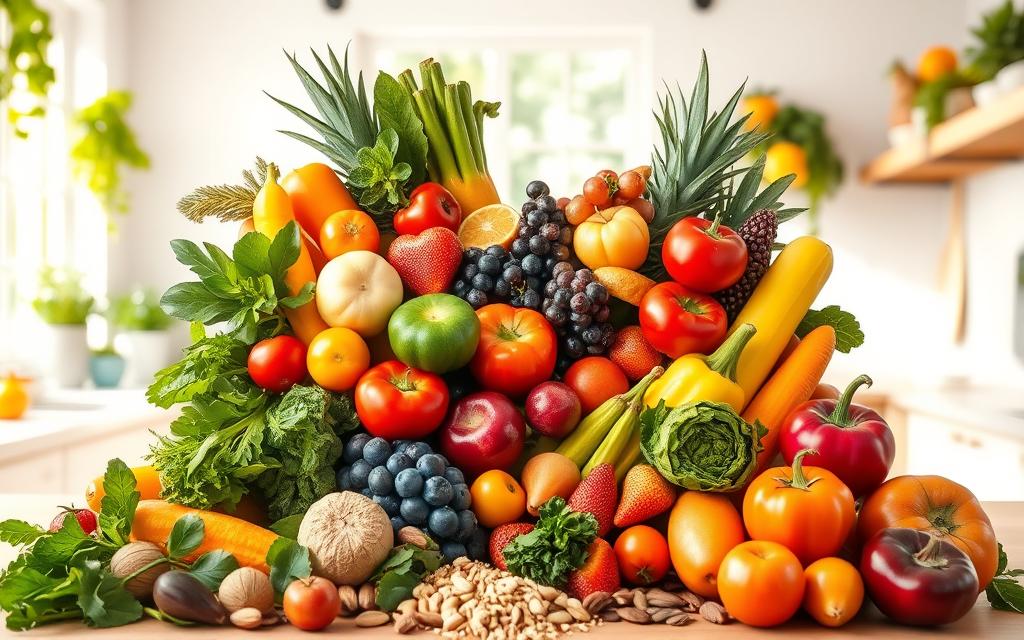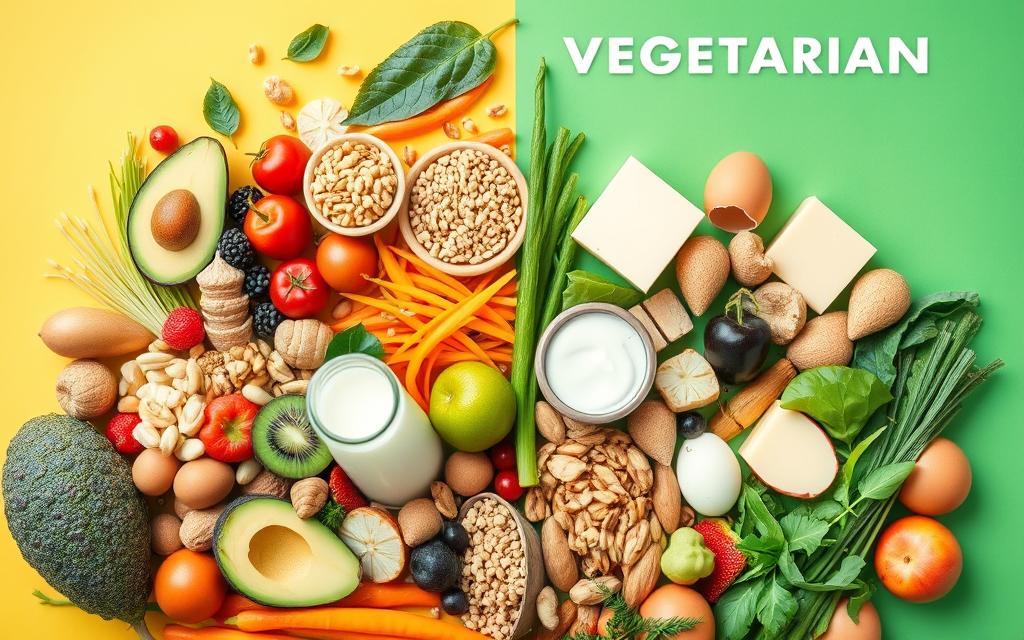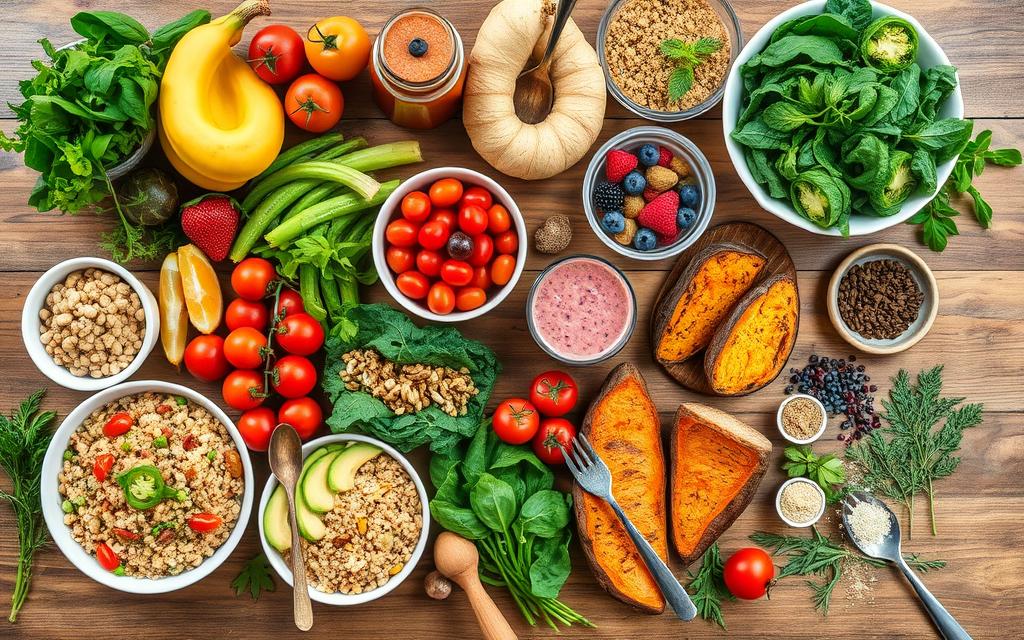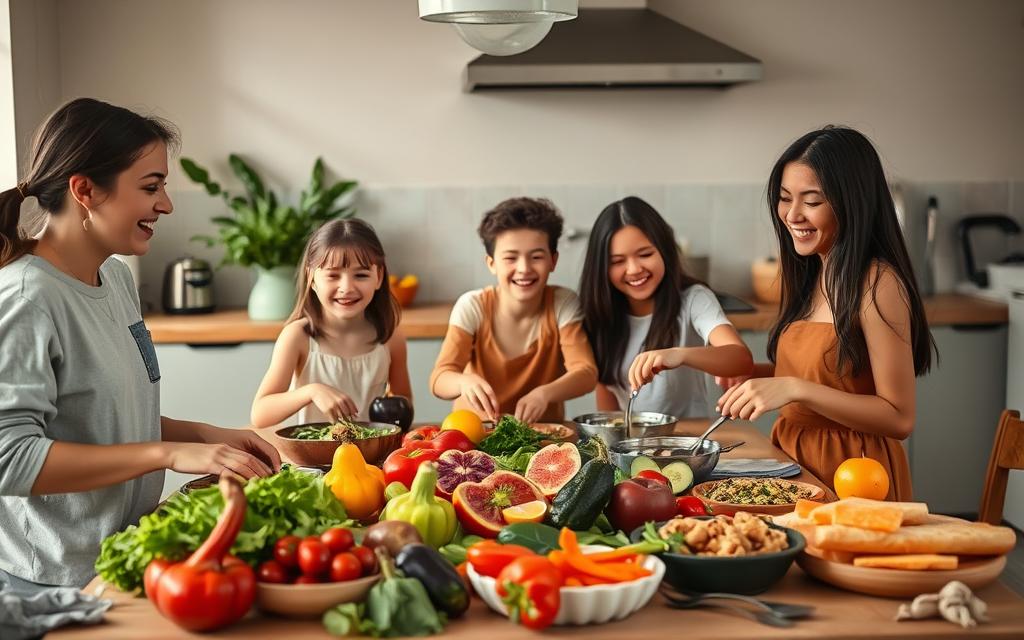Choosing plant-based diets is a big step towards a better life. It’s about more than just what we eat; it’s about how our choices affect our health and the planet. By eating plant-based, we can feel better and help the environment at the same time.
About 40% of people choose their food based on wanting to help the planet1. Going vegan means we care about our health and the planet. It’s a way to live that’s good for us and the Earth.
Exploring plant-based nutrition can lead to a healthier life. It might be hard at times, but the benefits are worth it. Let’s look at the good things and how to start eating more plants.
Key Takeaways
- The trend toward plant-based diets is growing, reflecting a shift towards cleaner eating.
- Plant-based diets enhance energy levels and have the potential to increase lifespan.
- Engaging in “plant-forward” eating allows for incorporating a variety of food types with flexibility.
- Starting with one plant-based meal per day can ease the transition to a fully vegan diet.
- Plant-based foods are high in fiber and low in unhealthy fats, benefiting heart health.
Understanding Plant-Based Diets
A plant-based diet mainly includes foods from plants like fruits, vegetables, nuts, seeds, and whole grains. It might also include legumes and beans. This diet often has little to no animal products, making it vegan or vegetarian. Knowing about plant-based diets helps us choose foods that are good for our health and the planet.
Studies show that almost 31% of adults are overweight, and over 42% are obese2. A plant-based diet can help with weight loss. A review of 12 studies found that people on such diets lost about 4.5 lbs (2 kg) over 18 weeks compared to those who ate meat2. This diet is also full of nutrients and can meet all our nutritional needs3.
Choosing plant-based nutrition is good for our health and the environment. Switching to less animal-based foods could cut greenhouse gas emissions by 70% and land use by 70% too. It could also reduce water use by 50% in Western diets2. It’s advised to make at least two-thirds of our meals plant-based, with animal products making up no more than one-third3.
By eating foods like tofu, lentils, beans, nuts, seeds, and quinoa, we can get enough protein. This makes the vegan lifestyle healthy and sustainable.
Health Benefits of a Plant-Based Diet
Switching to a plant-based diet can greatly improve our health. It helps with weight management and boosts heart health and cancer prevention.
Weight Loss and BMI Improvements
Studies show that plant-based diets help people lose weight and lower their BMI. A review found that vegans and vegetarians lose about 1 pound a week4. They also have lower obesity rates than those who eat meat4.
Plant foods are often lower in calories. This makes it easier to manage weight5.
Cardiovascular Health
A well-planned vegan diet can improve heart health. Research shows it lowers heart disease, high blood pressure, and cholesterol risks6. Eating more fruits, vegetables, and legumes can also help lower blood pressure and heart disease risk4.
People who eat more plant-based foods see big improvements in their cholesterol and blood pressure. This is great for their heart4.
Lowering Cancer Risks
Choosing a vegan diet can help lower cancer risks. Studies link eating more fruits and legumes to lower cancer risk, like colorectal cancer6. The World Health Organization says diet changes can help prevent cancer5.
By cutting out red and processed meats and eating more plant foods, we can fight cancer better4.

Vegan Diet vs Vegetarian Diet
It’s important to know the differences between vegan and vegetarian diets if you’re thinking about eating more plants. A vegetarian diet doesn’t include meat, fish, or shellfish but does include dairy and eggs. On the other hand, a vegan diet doesn’t include any animal products, including dairy and eggs.
Both diets have health benefits, but they differ. Vegetarians tend to eat more vitamins like C and E, and minerals like folic acid. This can lower the risk of diseases like obesity and heart disease7. Vegans also tend to have lower BMI and cholesterol levels8. But, vegans might face more risks of not getting enough nutrients, like vitamin B12 and iron7.
It’s also important to think about lifestyle. Both diets should include lots of fruits, vegetables, whole grains, and water. How we plan our diet can greatly affect our health and happiness.
| Aspect | Vegetarian Diet | Vegan Diet |
|---|---|---|
| Animal Products | Excludes meat, fish, shellfish; includes dairy and eggs | Excludes all animal-derived foods |
| Health Benefits | Lower risk of certain chronic diseases, higher vitamin intake | Lower BMI, reduced LDL cholesterol, may risk deficiencies |
| Nutritional Focus | Varied diet; emphasis on dairy sources for calcium | Focus on plant sources but potential for nutrient gaps |
| Risk of Deficiency | Less risk compared to vegans; mainly iron and B12 | Higher risk for vitamin B12, iron, omega-3 fatty acids |

Essential Nutrients in a Plant-Based Diet
Understanding essential nutrients is key to a healthy vegan lifestyle. By focusing on vegan nutrient planning, we can make sure our diets are balanced and nourishing. Important elements include plant-based protein sources and essential vitamins and minerals, crucial for health.
Importance of Protein Sources
Getting enough vegan protein is vital for our well-being. Proper planning helps most vegetarians and vegans meet their protein needs. Adults need about 0.8 grams of protein per kilogram of body weight, which is about 55 grams for a 150-pound person9.
High-quality plant-based protein sources include legumes, nuts, seeds, and fermented soy products like tempeh. These foods provide necessary proteins and boost our nutrient intake.
Getting Enough Vitamins and Minerals
A vegan diet must include essential vitamins and minerals. Vitamin B12 is mainly found in animal products, so vegans need fortified foods or supplements10. We must focus on iron and calcium too.
Non-heme iron from plants is less absorbed than heme iron from meat, but many vegetarians manage their iron intake well10. Foods rich in vitamin C can help increase iron absorption from plant-based sources10. Fortified non-dairy alternatives and vegetables like kale and broccoli can also meet our calcium needs11.
| Nutrient | Recommended Intake | Plant-Based Sources |
|---|---|---|
| Protein | 0.8 g/kg body weight | Legumes, nuts, seeds, tempeh |
| Calcium | 1,000 mg/day (1,200 mg for women over 50) | Kale, broccoli, fortified non-dairy milk |
| Iron | Varies by age and sex | Legumes, grains, dark leafy greens |
| Vitamin B12 | Varies | Fortified foods, supplements |
| Omega-3 (ALA) | 1.6 g/day (males), 1.1 g/day (females) | Flaxseeds, chia seeds, walnuts |

Knowing these nutrient needs helps us plan our meals well. This ensures a happy and healthy lifestyle through our plant-based diet. It helps us avoid deficiencies and supports our health and energy10911.
Challenges When Transitioning to a Vegan Diet
Switching to a vegan diet can be tough, both physically and mentally. It’s hard when you’re out with friends or at family events and there’s little vegan food. This can make you feel left out or worried about being the only vegan.
Planning meals is another hurdle. You have to learn new recipes and ingredients, which can take time. Also, checking food labels is crucial since many products have animal products hidden inside. With more people going vegan, from 4 million in 2014 to 19.6 million in 2017, finding vegan options in animal-based markets is harder12.
It’s important to eat a variety of foods to get all the nutrients you need. Finding enough protein, vitamins, and minerals can be confusing. A 2018 survey showed that about two-thirds of people had cut down on meat, showing they face similar challenges. Yet, with support and effort, you can overcome these obstacles12.
To tackle these challenges, planning is essential. Create a meal plan with different plant-based foods. Following guidelines that focus on sustainability can help you stay on track with your health goals13. With the right mindset and preparation, you can enjoy the journey to a vegan lifestyle.
How to Start a Plant-Based Diet
Starting a plant-based diet can seem daunting. We need to plan carefully and set achievable goals. This helps us adjust slowly and confidently.
Setting Realistic Goals
It’s important to set realistic goals when starting a plant-based diet. About 25% of Americans are eating less meat, showing a trend toward plant-based eating14. We can set personal milestones and celebrate small wins. Talking to family and friends about our goals can also help us stay on track.
Creating a Meal Plan
A detailed meal plan is key for a smooth transition to veganism. Planning ahead ensures we eat a variety of fruits, vegetables, and more. This makes grocery shopping and cooking easier and more fun. A good plan can even save us money, with a whole-food, plant-based diet saving about $750 a year per person15.
Here’s a basic meal plan to get you started:
| Day | Breakfast | Lunch | Dinner |
|---|---|---|---|
| Monday | Oatmeal with fruits | Lentil salad with greens | Quinoa stir-fry with vegetables |
| Tuesday | Smoothie with spinach and banana | Chickpea wrap with veggies | Stuffed bell peppers |
| Wednesday | Avocado toast with tomatoes | Vegetable sushi rolls | Black bean tacos |
| Thursday | Chia seed pudding with almond milk | Homemade vegetable soup | Sweet potato and kale hash |
| Friday | Pancakes with maple syrup | Falafel salad | Vegetable curry with rice |
| Saturday | Smoothie bowl with nuts | Grilled vegetable sandwich | Pasta with marinara sauce and greens |
| Sunday | Fruit salad | Quinoa and black bean bowl | Roasted vegetables with quinoa |

Tips for Adopting Vegan Living
Starting a vegan lifestyle can be rewarding, even more so when we share it with our loved ones. Talking openly about our food choices helps build understanding and support. Explaining why we chose veganism can make meals together more enjoyable and meaningful.
Discussing how veganism helps the environment can unite us. It shows we’re all working towards a common goal.
Communication with Family and Friends
Talking about vegan cooking can make it seem less intimidating. Sharing our vegan meal successes can spark curiosity in others. Inviting friends to try our vegan dishes can be a fun way to share our new lifestyle.
Exploring Plant-Based Recipes
Exploring vegan recipes is a thrilling part of the journey. We can try out different cuisines that are naturally vegan. This opens up new possibilities in the kitchen.
Using vibrant recipe resources can improve our cooking skills and meet our nutritional needs. As we get better at vegan cooking, we can become more creative. This makes our meals not only tasty but also good for the planet.

Plant-Based Diets for Weight Loss
Understanding our dietary needs for weight loss is key when going plant-based. Focus on whole foods rich in fiber and low in calories. This helps manage weight while keeping us well-nourished. Vegan diets often lead to more weight loss than traditional diets.
Understanding Dietary Needs
Many Americans struggle with weight management. In fact, 95% have tried to lose weight in the last five years16. Yet, 44% say they’ve gained weight16. Choosing the right diet is crucial, as plant-based diets are often lower in calories but full of nutrients. For example, a study found people on a plant-based diet lost an average of 16 pounds in three months16.
Research Findings
Research on plant-based diets shows they’re great for losing weight. A study found those on a low-fat vegan diet lost 5.1 kg in 22 weeks, while the control group gained weight17. Another study showed those on a whole-food, plant-based diet lost an average of 11.5 kg in a year, compared to 1.6 kg for the control group17. Vegans also tend to have a lower BMI, averaging 23.6 kg/m², while nonvegetarians average 28.8 kg/m²17. These results prove plant-based eating is effective for weight loss and better health.
Balancing a Vegan or Vegetarian Diet
For a vegan diet, it’s key to get all the nutrients we need for good health. The American Heart Association says we should not eat more than 2,300 milligrams of sodium a day. This is important for our heart health18. Also, we should watch how much sugar we eat. Men should not have more than 9 teaspoons of added sugar a day, and women should limit it to 6 teaspoons18.
It’s important to eat a variety of foods. For a good vegetarian diet, we should eat 2 ½ cups of vegetables, 2 cups of fruits, and 6 ½ ounces of whole grains every day19. We also need to make sure we get enough iron and calcium. Vitamin C can help us absorb iron better, which is good for our health19.
Vegans have to be careful about getting enough vitamin B12. This vitamin is mostly found in animal products, which can lead to a deficiency19. Eating fortified foods or taking supplements can help. Also, our calcium needs change based on our age, gender, and family history. So, it’s important to choose foods that meet our specific needs18.
Starting a vegan or vegetarian diet can be done slowly. We can replace one meat or dairy product with a plant-based option each week. This makes it easier to adjust and helps us balance our diet over time18.
Finding Support for a Plant-Based Transition
Starting a plant-based diet can feel overwhelming. But, finding support makes it easier. Joining vegan support groups gives us great resources and encouragement. These groups are where we can share our experiences, recipes, and challenges.
Being part of a community is key to our success. Whether online or in-person, connecting with others helps us feel accountable and part of a group. Local centers host activities, cooking classes, and sessions that help us understand a community support for plant-based diet.
It’s important to know that many health organizations support plant-based diets. They highlight how these diets can lower disease risks and improve health20. These groups offer tips on meal planning and whole foods, helping us transition smoothly21.
Key Ingredients for Plant-Based Recipes
In our kitchen, we often use a variety of essential ingredients for plant-based cooking. These ingredients not only provide nutrition but also add flavor and creativity to our meals. Understanding these vegan cooking staples helps us make hearty and satisfying dishes.
Some common staples include lentils, chickpeas, quinoa, and various spices. For example, canned lentils help us meet our daily fruit and vegetable intake22. Dried lentils, which don’t need soaking, cook fast and are great for weeknight meals.
Quinoa is also a great choice because it has all essential amino acids, making it a complete protein source22. When paired with edamame, which gives almost 20% of daily fiber needs in just half a cup22, these ingredients offer many nutritional benefits.
Chickpeas are very versatile; we can make them in many ways, like in a quick hummus recipe that takes only 10 minutes23. Many recipes use canned tomatoes, garlic, and vegetarian chili seasoning for a rich flavor. With these ingredients, we can make meals like one-pot soups in about 20 minutes or hearty fritters in just 10 minutes23.
Each of these vegan cooking staples is crucial in our culinary adventures. They let us experiment and enjoy the rich diversity of plant-based cuisine. As we explore more plant-based recipes, we find that our meals can be both delicious and nourishing.
Common Misconceptions About Veganism
Many think vegan diets are low in protein. But, this is a common vegan myth. A varied vegan diet gets enough protein from legumes, tofu, and whole grains. It’s both nutritious and filling24.
Some believe vegan diets are too strict. They think you can’t enjoy your favorite foods anymore. But, eating small amounts of animal products can still meet your nutritional needs24.
Others think vegan diets are expensive. But, foods like beans and potatoes are often cheaper than meat. These foods were key in many historical diets24. Plus, even pricey fruits and veggies offer lots of nutrition in small amounts25.
Some worry vegan diets limit social dining. But, many restaurants now have plant-based options. This makes it easy to enjoy meals with friends and family24. Vegan diets can be both healthy and social25.
By debunking these myths, we can better understand vegan diets. This can lead to more acceptance and appreciation of plant-based eating.
Conclusion
Exploring the benefits of vegan diets shows they’re good for our health and the planet. A plant-based diet can lower blood pressure and cholesterol, reducing heart disease and Type II diabetes risks2627.
More people are choosing plant-rich diets, with a big increase in the last decade27. With the right plan and support, going vegan can be rewarding and healthy.
Going vegan can cut our carbon footprint by 50% and lower cancer risks by 40%26. This change is good for us and the planet.
FAQ
What is a plant-based diet?
A plant-based diet mainly includes foods from plants like fruits, veggies, nuts, seeds, and whole grains. It might also include legumes and beans. This diet often has little to no animal products, making it vegan or vegetarian.
What are the health benefits of a plant-based diet?
Eating plant-based can help you lose weight and improve your BMI. It also lowers cholesterol and heart disease risk. Plus, it might reduce cancer risks, thanks to eating more whole plant foods.
How can we ensure we get enough protein on a vegan diet?
Getting enough protein is key. Eat legumes, nuts, seeds, and soy products like tempeh and miso. There are many plant proteins that can meet our needs.
What nutrients should we be mindful of on a plant-based diet?
Watch out for Vitamins B12, D, calcium, iron, and zinc. These might be low in plant-based diets. Use fortified foods and supplements to avoid deficiencies.
How can we transition smoothly to a vegan diet?
Start by setting achievable goals and making a meal plan. Addressing challenges helps too. Slow changes make sticking to a vegan lifestyle easier.
What strategies can help us balance a vegan or vegetarian diet?
Rotate foods and check nutrient levels. Make sure meals have a variety of food groups. This keeps our diet balanced and healthy.
Are there misconceptions about following a vegan diet?
Yes, people often think vegan diets lack protein or are too strict. But, there are many nutritious vegan options. It’s important to share the truth about vegan diets.
How can we find support while transitioning to a plant-based diet?
Look for online and local support groups. Sharing our experiences and recipes helps build a community. This makes the transition more enjoyable.
What are some essential ingredients for plant-based cooking?
Must-haves include lentils, chickpeas, quinoa, tofu, and spices. These help make tasty, healthy meals. They keep our diet interesting and satisfying.
